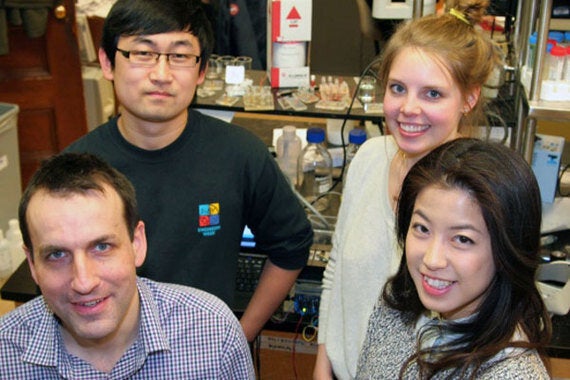
While some of us are using the new power of 3D printers to make smartphone cases and chocolate figurines, two engineering students from the University of Toronto are using them to print functional human skin.
On September 18, Arianna McAllister and Lian Leng were named the Canadian winners of the 2014 James Dyson Award for their invention, the PrintAlive Bioprinter.

Meet the team that developed the 3D skin printer, clockwise from top left: Boyang Zhang, Arianna McAllister, Lian Leng, Prof. Axel Guenther
The machine -- created in collaboration with Professor Axel Guenther, alumnus Boyang Zhang and Dr. Marc Jeschke, head of Sunnybrook Hospital's Ross Tilley Burn Centre -- prints large, continuous layers of tissue that recreate natural skin.
With serious burn victims, doctors typically must remove part of the patient's healthy skin and graft it onto the burned area. With PrintAlive, this painful step could be eliminated. The printed product includes hair follicles, sweat glands and other human skin complexities, providing an on-demand skin graft for burn victims.
Better yet, the machine uses the patient's own cells, which McAllister said "would completely eliminate immunologic rejection, and the need for painful autografting and tissue donation."
No larger than an average microwave, it's also portable and can print skin grafts on the go, potentially revolutionizing burn care in rural and developing areas around the world.
"Ninety per cent of burns occur in low and middle income countries, with greater mortality and morbidity due to poorly-equipped health care systems and inadequate access to burn care facilities," said Jeschke. "Regenerating skin using a patient's own stem cells can significantly decrease the risk of death in developing countries."
Since 2008, the team has developed hundreds of design iterations to optimize how the machine operates. Recently completing a second generation, pre-commercial prototype of the machine, they hope to scale up their device from its current bench-top process to a higher volume automated process.
Winning $3,500 in this leg of the competition, the duo now competes for the international James Dyson Award, which offers a prize of over $60,000 to inventors and their university, to be announced this November. The award was created by vacuum tycoon James Dyson to inspire students around the world to "design something that solves a problem."
ALSO ON HUFFPOST:
